To film seasonal landscapes with drones, start by selecting a drone with a stabilized 4K camera and long flight time. Plan your shoots around ideal lighting conditions for each season, such as golden hour for warm autumn hues. Master your drone's controls and composition techniques to capture stunning aerial perspectives. Consider weather factors like wind and temperature, which can affect your drone's performance. Familiarize yourself with local regulations and no-fly zones before taking off. Post-processing is essential for enhancing seasonal colors and creating a cohesive narrative. With the right approach, you'll transform fleeting moments into breathtaking seasonal footage that tells nature's ever-changing story.
Choosing the Right Drone

When it comes to filming seasonal landscapes, selecting the right drone is vital. You'll want a model that can handle various weather conditions and capture high-quality footage. Look for drones with stabilized 4K cameras, long flight times, and wind resistance.
Consider the DJI Mavic 3 or Air 2S for professional-grade results. These drones offer excellent image quality, obstacle avoidance, and intelligent flight modes. For beginners, the DJI Mini 2 or Autel EVO Nano+ provide good performance in a compact package.
Verify your drone has GPS positioning and a "return to home" feature for safety. Check its operating temperature range to confirm it can handle cold winter days or hot summer afternoons. If you're filming in wet conditions, choose a drone with water resistance.
Battery life is vital for capturing seasonal changes. Opt for drones with at least 30 minutes of flight time, and carry spare batteries.
Understanding Seasonal Light Conditions

Seasonal changes dramatically affect light conditions, making it vital for drone operators to understand and adapt to these variations. As you plan your aerial shoots, consider how each season impacts the quality, direction, and duration of light.
In spring, you'll encounter softer light and longer days, ideal for capturing vibrant new growth.
Summer brings harsh midday light, so aim for golden hour shots in early morning or late afternoon.
Fall offers warm, golden hues and dramatic shadows, perfect for showcasing colorful foliage.
Winter's low-angled light creates long shadows and a cool, crisp atmosphere.
To adapt to these conditions, adjust your drone's camera settings. In bright summer light, use a lower ISO and faster shutter speed. For darker winter scenes, increase ISO and slow down the shutter. Always monitor your histogram to guarantee proper exposure.
Consider using ND filters to control light intake, especially during bright conditions. They'll help you maintain desired aperture and shutter speed settings.
Planning Your Shoot

Successful drone landscape photography invariably begins with thorough planning. Start by researching your location, focusing on seasonal changes, local regulations, and potential hazards. Use apps like Google Earth and SunCalc to scout the area and determine the best time for ideal lighting.
Create a shot list that includes different angles, altitudes, and compositions you'd like to capture. Consider the unique characteristics of each season and how they'll impact your shots. Plan for multiple visits if possible, as weather conditions can change rapidly.
Check weather forecasts and choose days with perfect conditions for your desired shots. Wind speed is essential; aim for calm days to guarantee stable footage. Don't forget to factor in battery life and flight time limitations when planning your shoot duration.
Prepare your equipment in advance. Confirm your drone's firmware is updated, batteries are charged, and memory cards have sufficient space. Pack spare batteries, propellers, and lens cleaning supplies.
If you're filming in cold conditions, bring hand warmers to keep your batteries at ideal temperature.
Mastering Drone Flight Controls
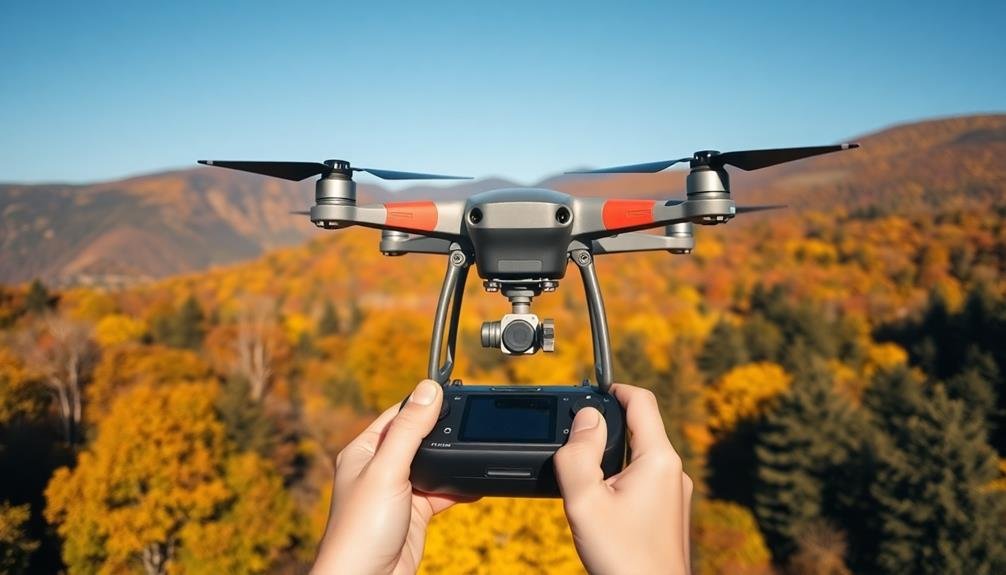
With your shoot planned, it's time to focus on the heart of drone photography: mastering your flight controls. Familiarize yourself with your drone's remote controller, paying attention to the joysticks that control altitude, rotation, and directional movement. Practice smooth, deliberate movements to capture steady footage.
Learn to use intelligent flight modes like orbit, waypoints, and tracking shots. These automated features can help you achieve complex shots with precision. Experiment with different speeds and altitudes to create varied perspectives of the landscape.
Master the art of panning and tilting the camera gimbal while flying. This skill allows you to create dynamic shots that reveal the full beauty of seasonal changes. Practice flying in various weather conditions, always within legal and safe limits.
Develop your spatial awareness to navigate obstacles and maintain visual line of sight. Use your drone's first-person view (FPV) feature to frame shots accurately, but always keep an eye on your surroundings.
Remember to adjust your flight patterns based on wind conditions to maintain stability and capture smooth footage of the changing seasons.
Composition Techniques for Aerial Landscapes

Once you've mastered flight controls, it's time to focus on composition techniques for aerial landscapes. Start by applying the rule of thirds to your shots, dividing the frame into a 3×3 grid and placing key elements along these lines or at their intersections. This creates a balanced and visually appealing composition.
Use leading lines to guide the viewer's eye through the image. Rivers, roads, or tree lines can serve as natural paths that draw attention to your main subject. Experiment with different angles and altitudes to find unique perspectives. Low-altitude shots can emphasize textures and patterns, while higher altitudes reveal grand landscapes and geological features.
Consider symmetry and patterns in your compositions. Natural and man-made elements often create interesting geometric shapes when viewed from above. Incorporate foreground elements to add depth and scale to your shots. This could be a lone tree, a building, or a person to provide context for the landscape's size.
Pay attention to lighting conditions. Golden hour and blue hour offer warm, soft light that enhances colors and creates long shadows, adding dimension to your aerial shots.
Capturing Spring Blooms
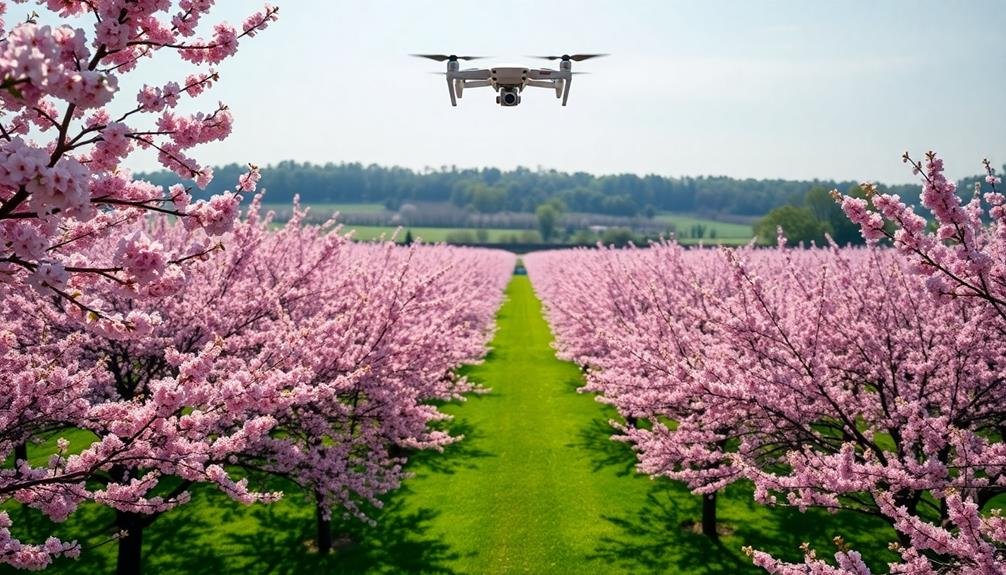
To capture spring blooms with your drone, you'll want to master specific flight patterns that showcase the vibrant colors and textures of blossoming landscapes.
You should plan your shoots during the golden hours of sunrise or sunset for ideal lighting conditions that enhance the beauty of the flowers.
It's essential to research and time your flights to coincide with peak blossom periods in your area, ensuring you don't miss nature's fleeting display.
Best Drone Flight Patterns
Spring blooms offer a stunning canvas for drone photography, and mastering the right flight patterns can elevate your footage from ordinary to extraordinary.
To capture the full scope of spring landscapes, start with a slow disclosure shot. Begin low, just above the flowers, then gradually ascend while moving backward. This creates a dramatic revelation of the colorful expanse.
For a dynamic perspective, try the orbit pattern. Circle your subject, whether it's a lone blossoming tree or a field of tulips, maintaining a consistent altitude and distance. This technique showcases the subject from all angles and adds depth to your footage.
Don't overlook the classic fly-through pattern. Plot a course that takes you through rows of flowering trees or over meandering paths lined with spring blooms. Keep your movements smooth and steady for the best results.
For a unique view, experiment with the top-down approach. Hover directly above your subject and slowly descend, revealing intricate patterns and textures in flower fields or gardens. This bird's-eye perspective offers viewers a fresh way to appreciate spring's beauty.
Optimal Lighting Conditions
During spring, lighting conditions play an essential role in capturing the vibrant beauty of blooming landscapes with your drone. You'll want to take advantage of the soft, warm light during golden hour, which occurs shortly after sunrise and before sunset. This light enhances the colors of spring flowers and creates a magical atmosphere in your footage.
To maximize your drone's potential, consider these ideal lighting conditions:
| Time of Day | Lighting Effect |
|---|---|
| Dawn | Soft, diffused light |
| Mid-morning | Clear, crisp light |
| Midday | Harsh shadows, vibrant colors |
| Late afternoon | Warm, golden light |
| Dusk | Dramatic sky colors |
Don't shy away from overcast days, as they can provide even lighting that's perfect for capturing the subtle hues of spring blossoms. Avoid flying in direct sunlight during midday, as it can create harsh shadows and overexpose your footage.
Remember to adjust your drone's camera settings to match the lighting conditions. Use a lower ISO in bright light to reduce noise, and increase it in low-light situations. Experiment with different white balance settings to accurately capture the colors of spring flowers and new foliage.
Timing Blossom Peak Periods
As the first signs of spring emerge, capturing the perfect moment when blossoms reach their peak becomes crucial for stunning drone footage. To time your shoots accurately, research the typical bloom periods for different tree species in your area. Cherry blossoms, for example, often peak for just a few days, while magnolias may last longer.
Monitor local botanical gardens and parks for updates on bloom progress. Many maintain online trackers or social media accounts with current information. You'll also want to keep an eye on weather forecasts, as unseasonably warm or cold temperatures can affect blooming schedules.
Once you've identified the ideal time, plan multiple shoots over several days to guarantee you don't miss the peak. Arrive early in the morning for the best light and to avoid crowds. Be prepared to adjust your plans if weather conditions change suddenly.
Consider using time-lapse techniques to showcase the gradual opening of blossoms. This can add a dynamic element to your footage.
Additionally, scout locations in advance to find the most visually appealing clusters of trees or unique landscape features that will complement the blossoms in your drone shots.
Summer Landscape Drone Photography
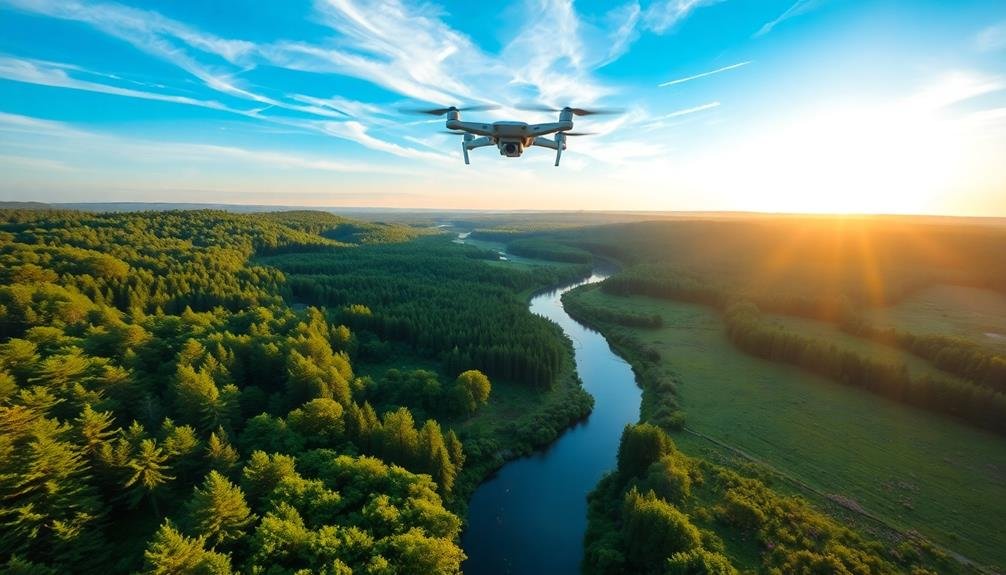
Summer's vibrant colors and long days offer drone photographers a wealth of opportunities for capturing stunning landscapes. To make the most of this season, you'll want to focus on the lush greenery, expansive fields, and bright blue skies that characterize summer scenery.
Start by scouting locations that showcase summer's beauty, such as sunflower fields, coastal areas, or rolling hills. Plan your flights during the golden hours – just after sunrise or before sunset – when the light is soft and warm, creating long shadows and enhancing textures.
Consider using polarizing filters to reduce glare and enhance the vibrancy of colors, especially when filming water or foliage. Experiment with different altitudes to capture unique perspectives, from low-flying shots that showcase ground-level details to high-altitude views that reveal patterns in the landscape.
Don't forget to incorporate movement in your shots. Use slow, smooth pans and gentle ascents or descents to add dynamism to your footage. Capture the essence of summer by including elements like flowing rivers, rustling cornfields, or beachgoers enjoying the sun.
Lastly, be mindful of local regulations and wildlife. Avoid disturbing nesting birds or other animals, and always prioritize safety and respect for the environment in your drone photography.
Autumn Foliage From Above
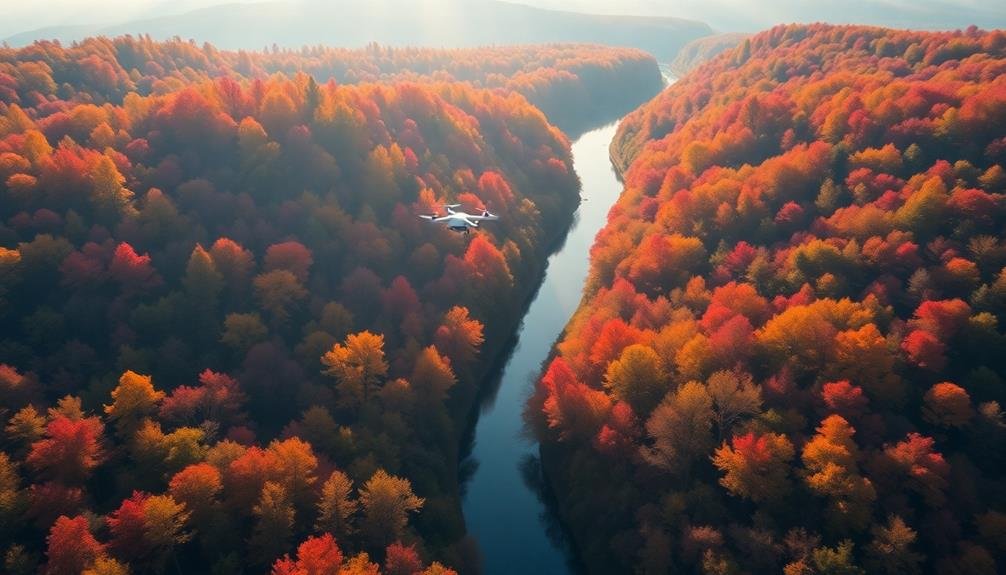
To capture autumn's peak color moments, you'll need to time your drone flights carefully, monitoring local foliage reports and weather patterns.
When you've identified the perfect window, consider flying your drone in sweeping patterns that showcase the vast tapestry of colors below.
Try combining wide aerial shots with closer fly-throughs to highlight both the grand scale and intricate details of the autumn landscape.
Capturing Peak Color Moments
Autumn's vibrant palette offers drone pilots a spectacular opportunity to capture breathtaking aerial footage. To seize the peak color moments, you'll need to time your flights perfectly. Research the foliage patterns in your area and stay updated on local fall foliage reports.
Usually, mid-October is prime time for most regions, but this can vary depending on latitude and elevation.
When you're ready to capture the magic, consider these tips:
- Fly during the golden hour for warm, soft lighting that enhances autumn hues
- Use polarizing filters to reduce glare and boost color saturation
- Experiment with different altitudes to showcase the landscape's scale
- Incorporate natural features like rivers or lakes for added visual interest
Don't forget to adjust your camera settings for ideal results. Shoot in RAW format to preserve detail and allow for more flexibility in post-processing.
Slightly underexpose your shots to prevent blown-out highlights and maintain rich colors. Remember, timing is essential – the peak color period often lasts only a few days, so be prepared to act quickly when conditions are perfect.
Ideal Drone Flight Patterns
When capturing autumn foliage from above, your flight patterns can make or break the shot. Start with a slow, steady ascent to reveal the landscape gradually. This builds anticipation and allows viewers to appreciate the scale of the colorful scenery.
Once at your desired altitude, try a gentle forward motion to showcase the expanse of fall colors. For dynamic shots, incorporate smooth pans and tilts. Slowly rotate your drone 360 degrees to capture a panoramic view of the autumn landscape.
You can also try a reveal shot by flying backwards, starting with a close-up of vibrant leaves and pulling away to expose the broader scene. Don't forget to experiment with different altitudes. Low-flying patterns just above the treetops can highlight texture and individual trees, while higher flights showcase the patchwork of colors across a wider area.
For added interest, try a gentle zigzag pattern to weave through different color zones. Lastly, consider a slow descent to end your footage, bringing viewers back to earth and providing a sense of closure to your autumn foliage sequence.
Winter Wonderland Aerial Shots
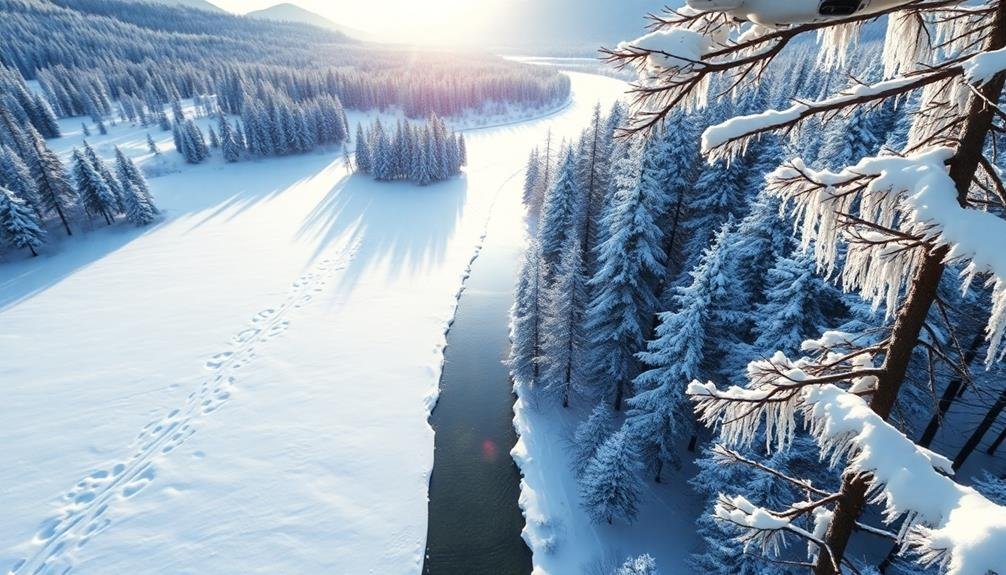
With winter's arrival, capturing snowy landscapes from above creates breathtaking aerial footage. You'll want to focus on the stark contrast between white snow and dark trees or buildings. Look for patterns in the snow, such as windswept drifts or animal tracks, which can add interest to your shots.
When filming winter wonderland scenes, consider these key elements:
- Light: The low winter sun can cast long shadows, creating dramatic effects. Early morning or late afternoon light often provides the best results.
- Weather: Overcast days can produce a soft, ethereal quality, while clear skies offer crisp, high-contrast images.
- Color: Incorporate pops of color, like red barns or colorful ski gear, to break up the monochromatic white landscape.
- Movement: Capture falling snow or skiers in motion to add dynamism to your footage.
Remember to protect your drone from the cold and moisture. Use hand warmers on your batteries to maintain their charge, and allow your drone to acclimate to the temperature before flying.
Be cautious of ice buildup on propellers and sensors. Always prioritize safety, avoiding flights in heavy snowfall or strong winds.
With careful planning and execution, you'll create stunning winter aerial footage that showcases the season's unique beauty.
Weather Considerations for Drone Filming
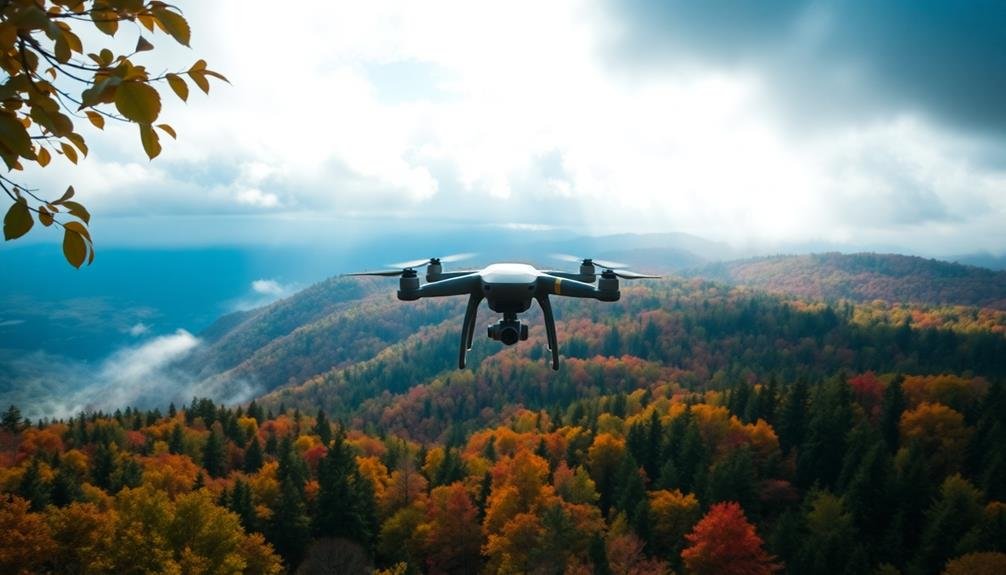
Weather plays an important role in drone filming, often dictating when and how you can capture your desired shots. You'll need to take into account various weather conditions to guarantee both safety and ideal footage quality.
Wind is a key factor. Strong gusts can destabilize your drone, affecting image stability and battery life. Aim to fly in winds below 20 mph for most consumer drones.
Temperature extremes can impact battery performance; cold weather greatly reduces flight time, while extreme heat may cause overheating.
Moisture is another concern. Avoid flying in rain, snow, or fog, as these can damage your drone's electronics and obscure your camera lens.
Lighting conditions are essential for capturing stunning landscapes. Golden hour, just after sunrise or before sunset, offers warm, soft light ideal for filming. Overcast days provide diffused light, reducing harsh shadows.
However, be cautious of rapidly changing weather. Check forecasts and use weather apps specifically designed for drone pilots. Always have a backup plan and be prepared to postpone your shoot if conditions are unfavorable.
Post-Processing Seasonal Footage
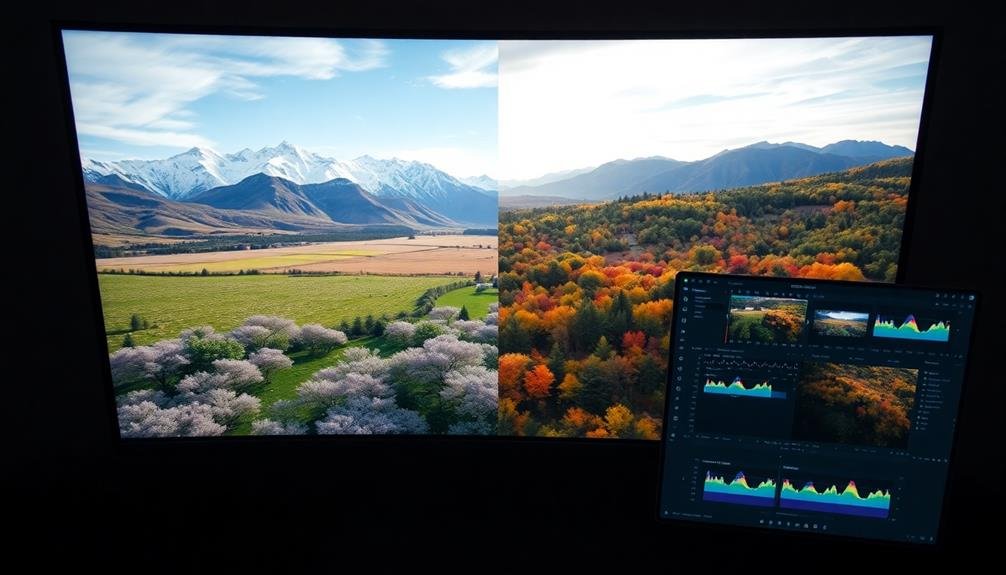
Once you've captured your seasonal landscape footage, post-processing becomes your next focus. It's crucial to enhance your raw footage to truly bring out the beauty of each season.
Start by color grading your clips to accentuate the unique hues associated with each time of year. For autumn, emphasize warm oranges and reds; for winter, highlight cool blues and whites.
Next, consider stabilizing your footage if there's any unwanted shake. While drones offer smoother shots than handheld cameras, wind and other factors can still cause minor turbulence. Use your editing software's stabilization features to guarantee buttery-smooth motion.
To create a cohesive seasonal narrative, follow these steps:
- Organize your clips chronologically or by visual theme
- Adjust exposure and contrast to maintain consistency across shots
- Apply subtle shifts that complement the season's mood
- Add appropriate music or ambient sounds to enhance the viewer's experience
Don't forget to crop or reframe your shots if needed, as drone footage often captures more than necessary.
Legal Aspects of Drone Filming
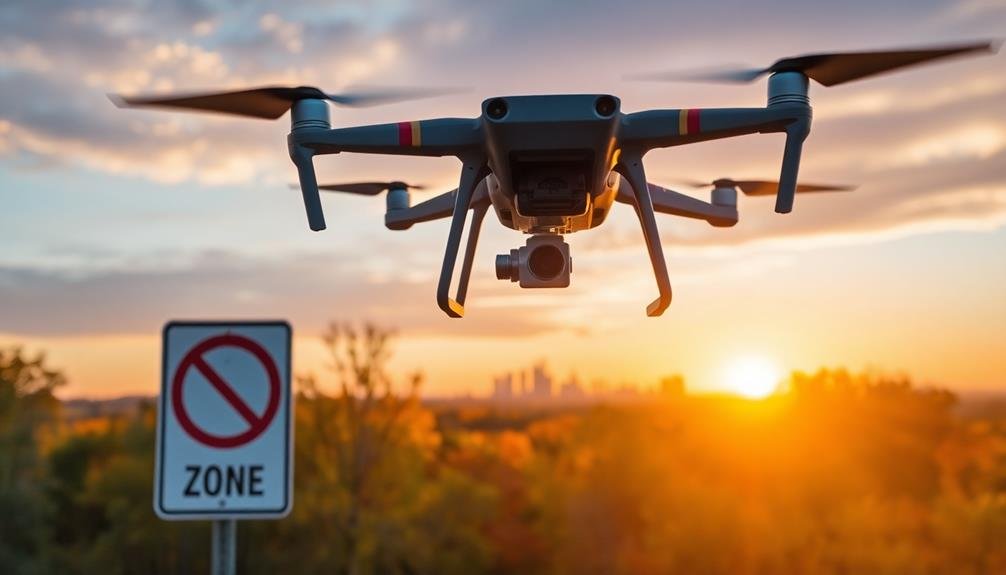
When filming seasonal landscapes with drones, you'll need to navigate vital legal requirements.
You must obtain proper licensing and registration for your drone, and be aware of restricted flying zones in your area.
It's also essential to respect privacy laws and secure necessary permissions before capturing footage of private property or individuals.
Licensing and Registration Requirements
Maneuvering the legal landscape of drone filming is essential before you take to the skies. In the United States, you'll need to comply with the Federal Aviation Administration's (FAA) regulations for unmanned aircraft systems (UAS).
First, register your drone with the FAA if it weighs more than 0.55 pounds. You'll also need to obtain a Remote Pilot Certificate by passing an aeronautical knowledge test.
For commercial drone use, including filming landscapes for profit, you must adhere to Part 107 rules. These include:
- Flying only during daylight hours or civil twilight
- Keeping your drone within visual line of sight
- Flying at or below 400 feet above ground level
- Avoiding flying over people or moving vehicles
It's vital to check local regulations, as some areas may have additional restrictions or permit requirements.
National parks, for instance, generally prohibit drone use without special permission. Always research the specific rules for your intended filming location.
Restricted Flying Zones
Although you've obtained the necessary licenses and registrations, you'll still need to be aware of restricted flying zones when filming seasonal landscapes with your drone.
These areas are off-limits for drone operations due to safety, security, or privacy concerns.
Common restricted zones include airports, military bases, national parks, and critical infrastructure. You'll need to check local regulations and use apps like B4UFLY or AirMap to identify no-fly zones in your filming area.
Some locations may require special permissions or have specific altitude restrictions.
Be cautious of temporary flight restrictions (TFRs) that can be implemented during events, emergencies, or VIP movements. Always respect private property and maintain a safe distance from people, vehicles, and structures.
When filming in urban areas, be aware of controlled airspace around airports and heliports.
In rural settings, watch for wildlife preserves and protected habitats. Coastal areas may have restrictions to protect marine life or sensitive ecosystems.
Privacy and Permissions
Beyond traversing restricted zones, you'll need to reflect on privacy laws and obtain necessary permissions when filming seasonal landscapes with your drone.
Always respect people's privacy and property rights. Don't fly over private land without the owner's consent, and avoid capturing footage of individuals without their permission.
Before launching your drone, research local regulations and obtain any required permits. Many national parks and protected areas require special authorization for drone use.
You'll also need to take into account noise restrictions, especially in residential areas or wildlife habitats.
To guarantee you're flying legally and ethically:
- Check local drone laws and regulations
- Obtain written permission from property owners
- Secure necessary permits for flying in protected areas
- Respect wildlife and maintain a safe distance from animals
When filming in public spaces, be mindful of others' privacy. Avoid capturing identifiable images of people without their consent.
If you plan to use your footage commercially, you may need additional releases or permissions.
Storytelling Through Seasonal Transitions
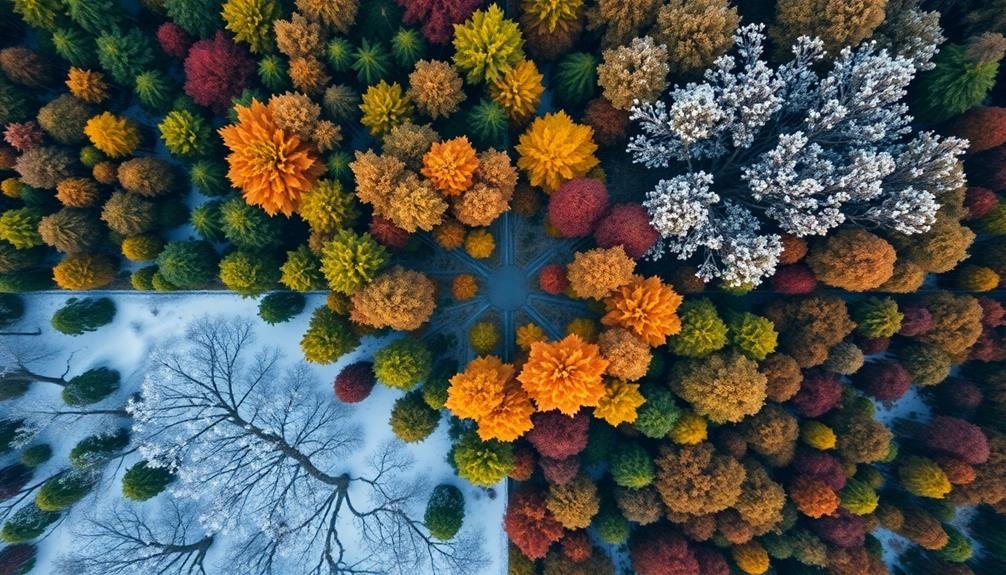
Seasons tell a story of change, and your drone can capture this narrative beautifully. To effectively convey this shift, plan your shots across different seasons. Start by identifying key landmarks or natural features that showcase seasonal variations. Create a shot list that includes these locations in each season.
Use consistent framing and camera movements to highlight the changes. For example, a slow reveal of a forest evolving from lush green to vibrant autumn colors can be powerful. Capture the same scene at dawn or dusk throughout the year to show how light and shadows shift.
Don't forget to include wildlife and human activities that change with the seasons. Migrating birds, harvesting crops, or winter sports can add depth to your story. Time-lapse sequences can compress months of change into seconds, creating a dramatic effect.
Pay attention to weather conditions unique to each season. Mist rising from a lake in fall, snow-covered landscapes in winter, or spring blossoms can evoke strong emotions.
Frequently Asked Questions
How Can I Protect My Drone From Extreme Temperatures During Seasonal Shoots?
To protect your drone from extreme temperatures, you'll want to insulate it, avoid sudden temperature changes, and store batteries properly. Use protective cases, limit flight time in harsh conditions, and warm up your drone gradually before flying.
What Are the Best Times of Day to Capture Seasonal Color Changes?
You'll capture the best seasonal color changes during the golden hours: just after sunrise and before sunset. Don't miss the soft, warm light that enhances autumn hues. Midday can work for winter scenes with snow.
How Do I Maintain Battery Life in Cold Weather Drone Operations?
You'll need to keep your drone's batteries warm. Use insulated battery bags, preheat them before flight, and avoid letting them cool between flights. Don't discharge below 30%, and return to land sooner than usual in cold conditions.
Are There Specific Drone Accessories Recommended for Filming in Different Seasons?
You'll want season-specific accessories for your drone. In winter, use propeller guards and lens filters. For summer, try ND filters and sun hoods. Don't forget extra batteries and a landing pad for all seasons.
How Can I Create Smooth Transitions Between Footage From Different Seasons?
You can create smooth shifts between seasonal footage by using dissolves, matching compositions, and color grading. Try overlapping similar elements or using motion to blend scenes. Don't forget to sync audio for seamless shifts between seasons.
In Summary
You've now got the tools to capture stunning seasonal landscapes with your drone. Remember to always prioritize safety, respect local regulations, and be mindful of the environment. As you practice, you'll develop your own unique style. Don't be afraid to experiment with different techniques and perspectives. With patience and persistence, you'll soon be creating breathtaking aerial footage that showcases the beauty of nature's changing seasons. Keep flying, keep learning, and enjoy the view from above!

As educators and advocates for responsible drone use, we’re committed to sharing our knowledge and expertise with aspiring aerial photographers.
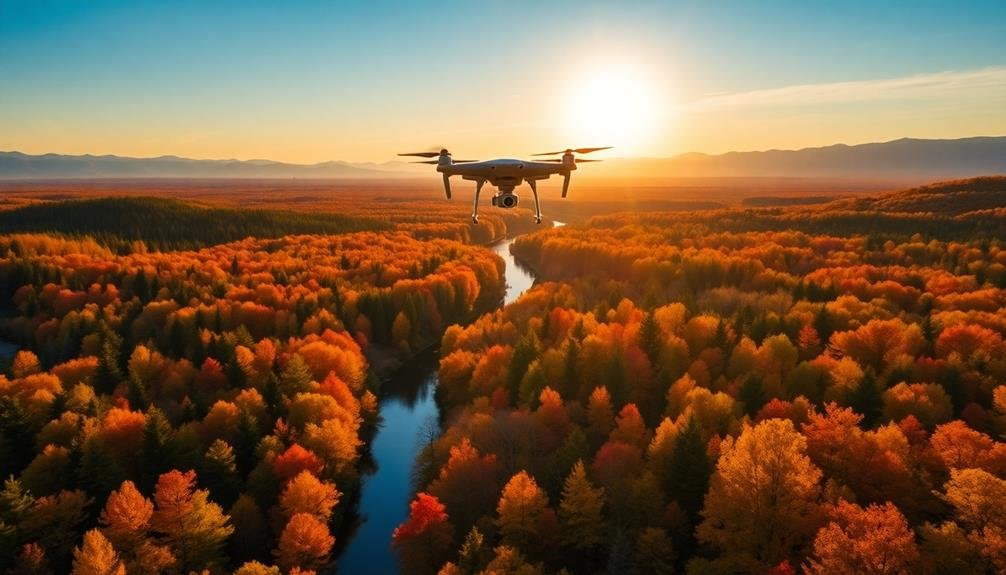



Leave a Reply